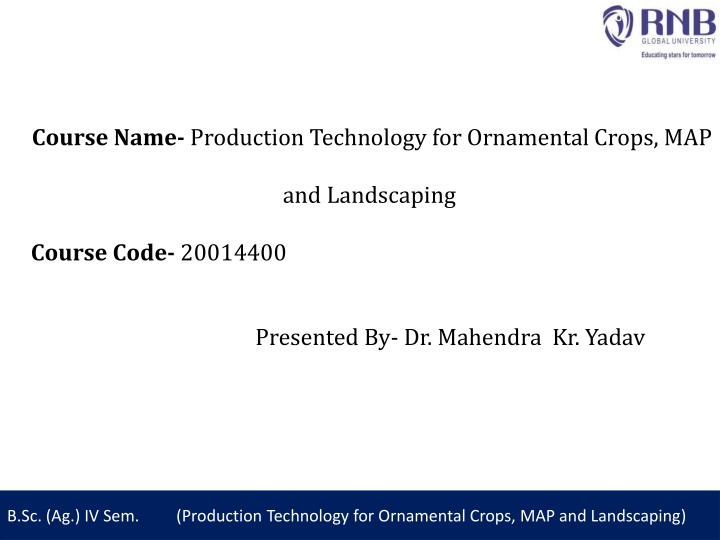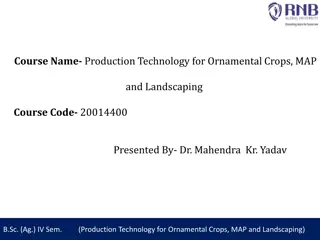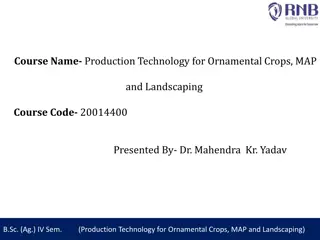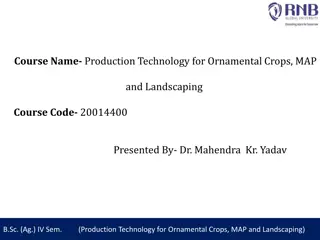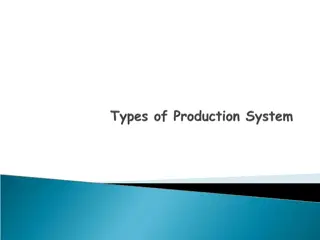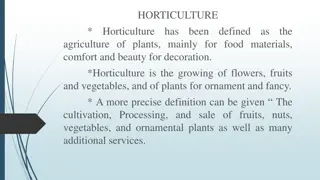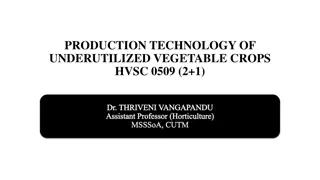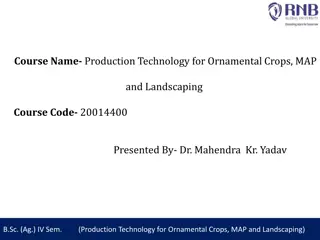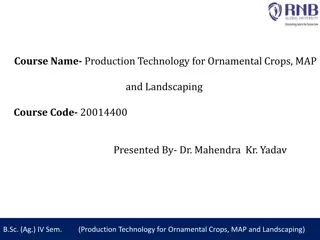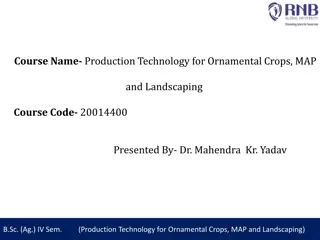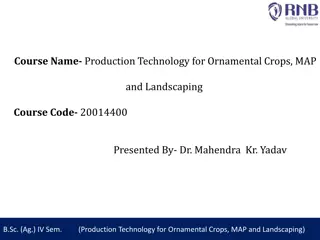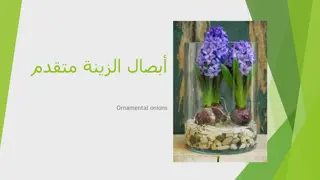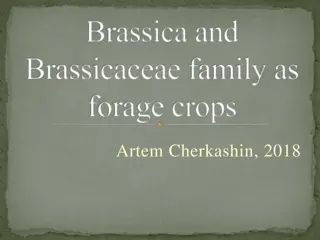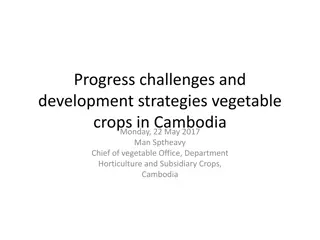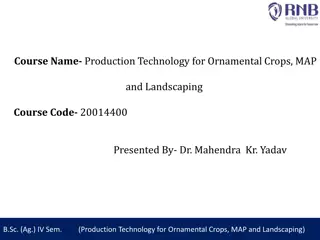Production Technology for Ornamental Crops and Landscaping
This course covers the production technology for ornamental and medicinal crops, landscaping principles, uses of landscape trees and shrubs, and more. It includes details on the production technology of Ocimum, focusing on its cultivation requirements, uses, and propagation methods.
Uploaded on Feb 22, 2025 | 4 Views
Download Presentation

Please find below an Image/Link to download the presentation.
The content on the website is provided AS IS for your information and personal use only. It may not be sold, licensed, or shared on other websites without obtaining consent from the author.If you encounter any issues during the download, it is possible that the publisher has removed the file from their server.
You are allowed to download the files provided on this website for personal or commercial use, subject to the condition that they are used lawfully. All files are the property of their respective owners.
The content on the website is provided AS IS for your information and personal use only. It may not be sold, licensed, or shared on other websites without obtaining consent from the author.
E N D
Presentation Transcript
Course Name- Production Technology for Ornamental Crops, MAP and Landscaping Course Code- 20014400 Presented By- Dr. Mahendra Kr. Yadav B.Sc. (Ag.) IV Sem. (Production Technology for Ornamental Crops, MAP and Landscaping)
Course Objectives Identify different types of ornamental and medicinal crops. Examine various principles of landscaping, uses of landscape trees, shrubs and climbers, production technology of important ornamental crops, etc. Determine about Demonstrate various Package of practices for loose flowers and their transportation, storage house and required condition for cut and loose flower. Construct about the various problems with the production technology of medicinal and aromatic plants. Importance of Processing and value addition in ornamental crops and MAPs produce. B.Sc. (Ag.) IV Sem. (Production Technology for Ornamental Crops, MAP and Landscaping)
Production technology of Ocimum B.Sc. (Ag.) IV Sem. (Production Technology for Ornamental Crops, MAP and Landscaping)
Production technology of Ocimum Local name: Sacred basil / Holy basil (English), Tulsi (Hindi, Gujarati, Sanskrit) Botanical name : Ocimum sanctum (Linn). Family name : Lamiaceae Chromosome No. : 2n = 32 Medicinal Use: Tulsi is an aromatic medicinal plant is often taken in combination with other herbs. The fragrant leaves and flowers, in the form of tincture, tea or decoction are considered to be stomachic and expectorant, used in treating coughs, bronchitis, skin diseases, and diarrhea. These preparations are considered to be prophylactic against epidemics including cholera, influenza and malaria. The tulsi seeds, taken mixed in water, juice or cow s milk, are antioxidant, nourishing, mucilaginous and demulcent. B.Sc. (Ag.) IV Sem. (Production Technology for Ornamental Crops, MAP and Landscaping)
Soil condition: Sacred basil thrives well on a wide range of soils. Rich loam, poor laterite, saline and alkaline to moderately acidic soils are also well suited for its cultivation. Well drained soil helps in better vegetative growth. Water logged conditions can cause root-rot and results in stunted growth. Climate: It flourishes well under fairly high rainfall and humid conditions. Long days and high temperatures have been found favourable for plant growth and oil production. It can grow up to an altitude of 900 m. The plant is moderately tolerant to drought and frost. The plant can be grown under partially shaded conditions but with low oil contents. B.Sc. (Ag.) IV Sem. (Production Technology for Ornamental Crops, MAP and Landscaping)
Planting time: The nursery can be raised in the third week of February and transplanting is generally done in the middle of April Improved varieties: R.R.L.O.C.-11, R.R.L.O.C.-12, R.R.L.O.C.-14. CIM-Angana, CIM-Ayu, CIM-Kanchan. Propagation: Tulsi is propagated through seeds. Seeds will get deteriorated over generations, due to its high crosspollination. Hence, for fresh plantings, the growers have to take fresh seeds from the pedigree stock. B.Sc. (Ag.) IV Sem. (Production Technology for Ornamental Crops, MAP and Landscaping)
Preparation of Nursery: Raised seed beds of 15 4 9 ft size should be thoroughly prepared and well manures by the addition of farm yard manure 10 kg per bed. About 200-300 g seeds are enough to raise the seedlings for transplanting in one hectare of land. The seeds are very small and hence it should be mixed with sand and sown to a depth of 2 cm. After sowing, the seeds in the nursery, a mixture of farm yard manure and soil should be spread in a thin layer over the seeds and irrigate with a sprinkler hose. The seeds germinate in 8-12 days and the seedlings are ready for transplanting in about 6 weeks time at 4-5 leaf stage. A spray of 2% urea solution on the nursery plants at 15 to 20 days before transplanting helps in getting healthy seedlings for transplanting. Land preparation: The land is brought to fine tilth and laid out into plots of convenient sizes. It is preferable to add 15 t/ha of farm yard manure and recommended fertilizers as basal dose during the preparation of land and should be mixed well in the soil. B.Sc. (Ag.) IV Sem. (Production Technology for Ornamental Crops, MAP and Landscaping)
Transplanting: Seedlings of six weeks old and having 4-5 leaves are transplanted at a spacing of 40 40 cm, 40 50 cm and 50 30 cm to get high herbage and oil yield. The plots are irrigated immediately after transplanting. The seedlings will establish well by the time of second irrigation. At this stage gap filling and replacement of the poor plants are also done so that uniform plant stand is achieved. Manure and Fertilizers: Farm yard manure / compost are to be applied at 10 t/ha before planting. Ensure that FYM / compost is well decomposed before use. The optimum fertilizer dose recommended for this crop is 120 kg N, 60 kg of P2 O5 and K2 O per hectare. Application of micronutrients, cobalt and manganese at 50 and 100 ppm concentrations respectively is reported to increase the oil yield significantly. Application of 120 kg N, 105 kg each of P2 O5 and K2 O per hectare is recommended for saline and alkaline soils. B.Sc. (Ag.) IV Sem. (Production Technology for Ornamental Crops, MAP and Landscaping)
Irrigation: Tulsis irrigation requirement depends upon the season and moisture content of soil. In summer three irrigations per month are necessary whereas, during other seasons it should be done as and when required except in rainy season when no irrigation is required. About 12-15 irrigations are required during the year. Apply mulch to conserve soil moisture.. Intercultural operation: Weeds have to be managed before they start competing with the main crop for nutrients and light. First weeding is done one month after planting and the second 4 weeks later. After this, no further weeding is required as the plants become bushy thereby suppress the weeds. One hoeing and earthing up operation is required at two months after planting. Use mulch to maintain soil moisture and to inhibit growth of weeds. Do not use chemical herbicides to eradicate weeds and do not keep weeds till flowering as this will increase weed pressure in coming years. Do not allow the soil to dry up due to excessive weeding. B.Sc. (Ag.) IV Sem. (Production Technology for Ornamental Crops, MAP and Landscaping)
Pests: Tulsi is found to be infested with few insect pests and diseases. Insect pests: Leaf rollers: Leaf rollers sticking to the under surface of the leaves, fold them backwards length wise and web them together. Tulsi lace wing, Cochlochila bullita: The adult and nymphs feed on leaves and younger stems, sometimes gregariously and leave their excreta making it unsuitable for use. Due to feeding, the leaves initially get curled and later the whole plant gets dried up. Control: Spray Azadirachtin 10,000 ppm @ 5 ml/l to control this insect. Diseases: The plant is susceptible to powdery mildew (Oidium spp.), seedling blight (Rhizoctonia solani) and root rot (Rhizoctonia bataticola). Powdery mildew can be controlled by spraying wettable sulphur (4 g/litre of water) and the latter two diseases can be managed by improved phyto-sanitary measures and by drenching the nursery beds with Bavistin 1%. B.Sc. (Ag.) IV Sem. (Production Technology for Ornamental Crops, MAP and Landscaping)
Harvesting: Care should be taken while harvesting Tulsi to avoid any type of contamination. Clean all the surfaces that comes into contact with the plant during and after harvest. The crop is to be harvested at full bloom stage to obtain maximum essential oil yield and better quality oil. The first harvest is obtained at 90-95 days of planting. Thereafter, it may be harvested at every 65-75 days interval. Harvesting should be done usually on bright sunny days for high and good quality oil. It is not desirable to harvest the crop if there was a rain in the previous day. The crop should be cut at 15-20 cm above the ground level. Expected yield: About 5 tonnes of fresh herbage per hectare can be obtained by two to three harvests in a year. The oil yield varies with type, season and place of origin. The whole herb contains 0.1-0.23% essential oil and an oil yield of 10-23 kg can be obtained per hectare.
